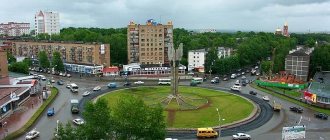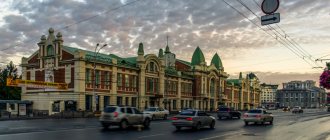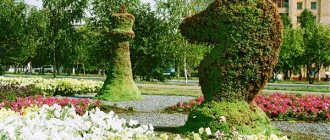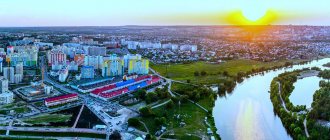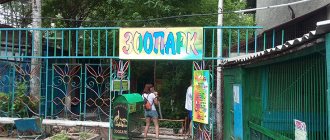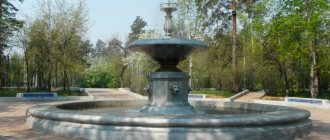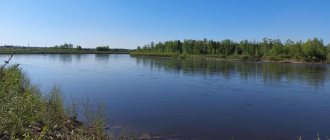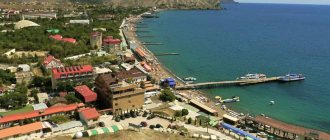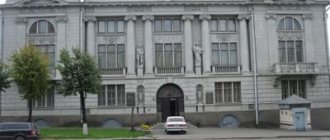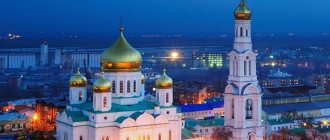The road to Tetyushi itself, especially if you make it along the water surface of the majestic Volga, is impressive and speaks for itself: these are ancient places with their own way of life, long-rooted traditions and often unusual sights. At the same time, the route to Tetyushi and back was always a trade one, because these are the places where the Russian Volga merchants flourished, in the pursuit of profit and capital, they never forgot about charity and public benefit for their native land.
Like many small Volga towns, residential development in Tetyushi is maximally concentrated in the historical center, dividing this part of the city with a system of rectangular blocks. At the same time, the main streets leading from the city, Lenin and Sverdlova, cross the territory from south to north and end with access to the high bank of the Volga, opening a magnificent panorama for viewing the great river. This is where the entrance to the city begins, and it is opened by the Trinity Cathedral standing on the shore.
The Tetyushi fortress itself, initially better known as the Tetyushi outpost, was built in 1574-1578, although there is a version dating back to 1557.
Located on the right bank of the Volga River, this ancient Russian fortification had both serious strategic and political significance. Tetyushi became the first in a series of Russian cities founded on the Middle Volga below Kazan immediately after its capture by the troops of Ivan the Terrible; a kind of first sign in a series of such impressive future outposts and important trading cities as Samara, Saratov, Tsaritsyn.
The name of the city has several versions of origin. One of them is associated with the semi-legendary Tetesh, the leader of one of the Bulgar tribes, who brought his people to these places, fleeing the devastation of Tamerlane’s army. It is also believed that Bulgars from the Temtyuzi tribe lived in the area. The Tatar expression “tau tash” is translated as “mountain-stone” or “mountain tooth”, since the local hills really consist largely of dense limestone. And finally, the Bulgarian “teus-tuye” - “walnut mountain” speaks of the once dense groves of hazel trees that grew around Tetyushi.
Tetyushi is repeatedly mentioned by famous foreign travelers, who have always shown great interest in the Volga as one of the greatest waterways of the European part of Muscovy. So, in 1636, the famous German scientist and diplomat, secretary of the Holstein embassy and Duke Frederick III, Adam Olearius, visited here.
According to fragmentary historical information, a monastery existed in these parts since the 16th century, which was later allegedly destroyed by robbers either in 1559 or in the subsequent Time of Troubles. The monastery was revived only at the end of the 19th century under the name of the Nikolaev Tetyush women's community. In addition, since the late 50s of the 16th century there was a church with its own parish.
In 1777, local landowner A. V. Strakhov, owner of the village of Narmonka (Fair), donated significant funds for the construction of a stone three-altar church in honor of the Holy Trinity in Tetyushi, becoming one of the first major city benefactors.
There was another reason for the construction of the Trinity Cathedral. By that time, Tetyushi was already considered a famous trading city and a center for the development of various crafts. But in order to receive the status of a city of county significance in those years, it had to have at least one large temple.
After the construction of the Trinity Cathedral, Tetyushi became a county town, part of the Kazan governorship (1781), and from 1802 - a county town of the Kazan province, and the Trinity Church with the left side chapel, consecrated in the name of the miraculous Kazan Icon of the Mother of God, and the right side - in honor of the saint Nicholas the Wonderworker, received the status of a city cathedral.
It is noteworthy that the current coat of arms of the Tetyushi municipal district is based on the image of the historical coat of arms of the district town of Tetyushi from 1781: “In a scarlet field there are two silver tournament knightly spears and two shields as a sign that the inhabitants of this place are service people who used in ancient times with praise these weapons." The wave stripes on the coat of arms mean the proximity of river waters, the red color symbolizes strength, courage and beauty, and the silver symbolizes purity and perfection.
It is difficult to imagine Tetyushi outside the development and historical destinies of the Middle Volga region of Russia. Thus, in the poem “Kazan and Order” (1912), the great Tatar poet Gabdulla Tukai wrote:
Oh, Kazan, you, like a lamp on a mountain, burn in the night, Like candles - minarets, bell towers, towers! The rays reach Spassk and Char, you illuminate Malmyzh, Chistopol and Cheboksary, Tetyushi and Mamadysh
Even the secrets and riddles of urban legends between Kazan and Tetyushi were often similar. The theme of dungeons and secret passages leading from Kazan far beyond the city limits has been known since the time of the capture of the city by the troops of Ivan the Terrible. Tetyushsky old-timers to this day can tell about the underground passages laid under the Trinity Cathedral of the city towards the Volga banks. After the end of the Great Patriotic War, residents of the areas adjacent to the cathedral, reviving and expanding their private gardens, allegedly more than once dug up the remains of stonework, often a meter high, or even greater.
Folklore always promptly responds to information requests from society. Against the background of numerous Turkic-language versions about the origin of the name of the city, there is also a humorous legend about a father and son, whose horse, harnessed to a cart, unexpectedly got stuck up to its face in thick road mud - a constant companion of provincial Russian towns. “Oh, daddy, ears!” - all he could see was an amazed child instead of a horse, and by evening the whole city was repeating this new joke, cheerfully rhyming it with the name of their hometown. The land here, to be honest, has always been swampy, but the Tetyushi Trinity Cathedral, taking this circumstance into account, was originally built on the solid soil of a high river bank, next to the current observation tower.
There was often an even more amazing and incomprehensible connection between various events and phenomena in the capital Kazan and provincial Tetyushi. Thus, in the Tetyush Trinity Cathedral, the miraculously revealed image of the Kazan Tetyush Icon of the Mother of God was kept for a long time and largely determined the spiritual life of the Orthodox community of the city. And this amazing phenomenon took place in a small Volga town only 9 years after the miraculous prototype of the icon was happily found in the county capital itself!
Aunties through the eyes of overseas pilgrims
In his famous, almost academic, “Description of a Journey to Muscovy” in 1647, Adam Olearius wrote: “Around noon we met the city of Tetyushi, located 120 versts from Kazan, high on the mountain and along its slope; it consists of scattered houses and churches, all built of wood and surrounded by a palisade instead of a wall.”
In 1711, he was echoed by the Dutch traveler, writer and artist Cornelius de Bruin on the pages of his “Travel to Muscovy”: “At noon we arrived at the small town of Tetyushi, or Tetyush, ninety miles beyond Kazan, on a high mountain on the right bank. It is surrounded by a wooden wall and consists of poor houses and small churches. Sailing past it, from the river you can only see part of its wall. Right there, on the bank of the river, there is a small village where our people went to look for some food and ice to cool our drinks, since here we noticed that there was still snow on the mountains.”
Population
| Population | ||||||
| 1856[15] | 1897[15] | 1913[15] | 1926[15] | 1931[15] | 1939[15] | 1959[16] |
| 2300 | ↗4800 | ↗7200 | ↘4800 | ↗5000 | ↗8600 | ↘7884 |
| 1970[17] | 1979[18] | 1989[19] | 1992[15] | 1996[15] | 1998[15] | 2000[15] |
| ↗8513 | ↗10 199 | ↗10 487 | ↗10 900 | ↗11 600 | ↗11 900 | ↗12 200 |
| 2001[15] | 2002[20] | 2003[15] | 2005[15] | 2006[21] | 2007[22] | 2008[23] |
| →12 200 | ↘11 931 | ↘11 900 | ↘11 800 | ↘11 488 | ↘11 408 | ↘11 400 |
| 2009[24] | 2010[25] | 2011[26] | 2012[27] | 2013[28] | 2014[29] | 2015[30] |
| ↘11 338 | ↗11 596 | ↘11 579 | ↗11 632 | ↘11 525 | ↘11 419 | ↗11 449 |
| 2016[31] | 2017[32] | 2018[33] | 2019[34] | 2020[1] | ||
| ↘11 410 | ↘11 337 | ↘11 250 | ↘11 136 | ↘10 991 | ||
As of January 1, 2022, in terms of population, the city was in 888th place out of 1,116[35]cities of the Russian Federation[36].
Residents and benefactors of the district town of Tetyushi
The hero of Gogol’s immortal comedy “The Inspector General,” Gorodnichy, had a very definite opinion about his district town N: “Yes, from here, even if you ride for three years, you won’t reach any state.” By the beginning of the 20th century, Tetyushi had approximately the same geographical location, but the local economy, cultural and spiritual life of this town had a significant advantage - a huge water artery, the great Russian Volga River.
It was thanks to the Volga that at the turn of two centuries Tetyushi, being a very small county town, played an important role in the district as a trade and economic center of the entire county. Remaining a large river port with developed infrastructure, Tetyushi was the local leader in the trade turnover of grain, bakery products and fish.
Dolgaya Polyana
How to get there: from Tetyushi to Dolgaya Polyana, 13 km along the Tetyushi - Kamskoye Ustye highway. Address: Solnechnaya, 21, Dolgaya Polyana, Tetyushsky district, Tatarstan, Russia Telephone: +7 (84373) 5-45-90, +7 (84373) 2-55-07 (museum) Opening hours: by appointment
13 kilometers from the city there is the estate complex “Dolgaya Polyana”, the former estate of the counts Molostvov, with an observation deck. There is a beautiful view of the Kuibyshev Reservoir and the Great Bolgar.
The glade is considered a mystical, anomalous zone. Amazing things happen on it: despite the surrounding forest, it has not been overgrown for several centuries, magnetic instruments go off scale here, clocks go astray, and frames taken from digital cameras inexplicably disappear.
The amazing estate of the ancient Molostvov family with its manor house, a larch alley, exotic trees and shrubs has been preserved here.
But the main mystery is the story of the “bare meadow,” which, according to local residents, has not been overgrown for many centuries in a row. No one has yet been able to solve this mystery. As an experiment, they tried to plant these anomalous clearings, but the trees did not take root.
Even the khans of the ancient Bulgars came to Dolgaya Polyana to enjoy the energy of this amazing place. And after Ivan the Terrible expelled the inhabitants of the Kazan Khanate from the coastal strip, stories about the amazing healing place passed from generation to generation.
Small town on a big river
The Volga fed and provided work for the townspeople and residents of the county, who were massively hired on trade and transport ships and as pier workers, especially during the summer and autumn fairs. The largest were two annual fairs: Kazan, held in June, and Vozdvizhenskaya, in September. Here you could purchase a wide range of goods at reasonable prices. It was here that capital was made, merchant families grew rich, and, consequently, the traditions of generous Russian merchant charity and enlightened philanthropy were born.
Gradually, large commercial and industrial dynasties emerged in Tetyushi. City merchants had surplus funds, and they quite consciously, and sometimes with a bit of vanity - why not? — they invested them in schools, hospitals, temples, and charitable causes. Charity in the Volga region has long-standing and strong roots, and representatives of such famous merchant dynasties as the Serebryakovs, Kolsanovs, Ashmarins, Krupins and other wealthy local businessmen invested in the improvement of Tetyushi.
Education
- MBOU "Tetyushskaya secondary school No. 1 named after Hero of the Soviet Union Pavel Semenovich Khanzhin."
- MBOU "Tetyushskaya secondary school No. 2".
- MBOU "Tetyush Tatar Secondary School".
- GBOU "Tetyushskaya cadet boarding school".
- FGOU SPO "Tetyushsky Agricultural College".
- GAPOU "Tetyushi State College of Civil Defense"
- Center for additional education of children of Tetyushsky municipal district
- Children's and youth sports school
- Branch of the State Budgetary Institution "Republican Specialized Children's and Youth Sports School of the Olympic Reserve" for skeet and bullet shooting of the Republic of Tatarstan.
- Tetyushsky interschool training center.
Temple organizers
The Serebryakovs were among the first “ancient” residents of Tetyushi; their name appears in the very first census book of the 17th century known today for the Kazan district, dated 1646. Other famous merchant families of the town are also mentioned in these documents; often their representatives lived nearby, on neighboring streets, for many years.
And today in the city many buildings of former estates or organizations, built with the money of wealthy fellow countrymen, have been preserved in a very tolerable condition. Among them is the city’s Trinity Cathedral, the needs of which always required funds.
For example, Pyotr Vasilyevich Serebryakov, who landscaped the Tetyushi city cemetery and established a house church at the prison castle, financed a large-scale overhaul of the Trinity Cathedral in 1904-1906. And ten years earlier, in 1897, the philanthropist donated 10 thousand rubles, a considerable sum at that time, for the organization of an orphanage for orphans named after V. G. Serebryakov, his late father, a merchant of the 1st guild. And he also opened an orphanage at the Trinity Cathedral, which is no coincidence: in this church all representatives of Tetyush’s Serebryakov dynasty were baptized, married and had funeral services!
“I’m not that kind of boss, I don’t need anything”: how is life in Auntie’s “Paradise”?
“I WOULD ALLOCATE A NEW PLOT FOR A CEMETERY. THE PEOPLE ARE NOT VERY STRONG NOW"
Frankly, about 10 years have passed since the last visit of the BUSINESS Online correspondent to Tetyushi.
And since then the city has changed for the better. The roads have been repaired, although the older generation grumbles about this too: “Before, everything was full of potholes, so cars dragged along like turtles. And now they’re driving so fast that they’ll hit him at any moment...” The bus station is unusually crowded. You can leave from here to Ulyanovsk and Cheboksary. And there are buses to Kazan almost every hour for 300 rubles. During the navigation period, you can still get there romantically on the Meteor. He arrives in Tetyushi at 11 am, and back at 3 pm. In the summer, this time is clearly not enough to experience at least a little of the magnificent nature and historical places.
On Friday mornings on the streets of Tetyushi you can meet mostly people of retirement age. And the locals themselves say that the city is far from being youthful: in search of study or work, many first spread out to larger cities. “Up to a third are probably leaving,” says a middle-aged man who introduced himself as Alexander . — We don’t have city-forming enterprises. There is only a branch of the Kazan Helicopter Plant, and it’s not easy to get a job there, because the salaries are good.” He himself works in the construction industry and has not had any complaints about the lack of orders lately. According to Alexander’s observations, the average salary in the city is something like 15 thousand rubles. It’s difficult to survive on this money, but dachas, vegetable gardens and fishing help. Tetyushi still stands on the Volga, so there are enough fishermen here. “With fish, of course, everything is not as good as it was before,” says our interlocutor. “The river used to bloom in August, but now, as soon as the ice melts, it turns green along the banks. And those fishermen who fish under licenses also contribute to the population. It also cannot be done without poachers, and sometimes they act in a rather barbaric way. And the power plant with its dam does not allow fish to move.”
Artem , joins the conversation . “We used to have everything of our own.” The dairy plant, the meat processing plant, and agricultural equipment were repaired. It’s no longer necessary—it’s not in demand, apparently. Everything was closed." According to the men, it cannot be said that nothing is being done in the area. Roads lead to the villages, but this should have been done several years ago. Schools in the villages are closed, they are enlarged and children are transported by buses.
However, a certain inertia is also felt in the behavior of the aunties. A BUSINESS Online correspondent has repeatedly asked: why don’t male residents break out and go to work where labor is needed? They answered: either there was not long left until retirement, or that the places and nature here were so beautiful that they could not exchange them for anything. Yes, and we lived our whole lives in Tetyushi... Although there are also many who leave as shift workers.
According to the local public, there was one global project in the area for the construction of a large brick factory, which in terms of capacity was supposed to be equal to four ordinary ones. It would be possible to produce 16 different shades. They poured the foundation, dug a pit, prepared access roads, built an administrative building, but trouble came: the crisis year of 2008 was upon us. And since the equipment for the plant had to be completely brought from Italy, the project was covered with a copper basin, the investor seemed to go bankrupt, and the unfinished complex still gapes as a reminder of unfulfilled dreams in the village of Zhukovo.
But there is also good news. “Here we somehow unexpectedly became a tourist city,” continues Alexander. “And even those who do not work in the tourism industry have felt the changes themselves. They put good asphalt in the center so that the dirt would not be visible, and the lighting was installed, and not, as before, through two pillars. But when there is no work and decent wages, it’s still sad, and these changes are not fully felt positively.” When asked what priority problem of the city they would solve if there was enough money for this, our interlocutors, after hesitating, admitted that it was necessary, first of all, to consult with the people about such things. For example, recently there was a self-taxation levy in Tetyushi, and people cannot say that they reacted with confidence to this initiative of the authorities.
“And I would allocate a new plot for a cemetery. The people today are not very strong,” Artem summed up the conversation.
BULLY WOMAN OR HORSE EARS?
Being in the center of Tetyushi, you plunge into the atmosphere of a merchant city. The houses look neat, and the store names, such as Albertic, are charming. From Mount Vshikha there are magnificent views of the Volga and its hilly banks. The mountain itself received this name according to one of the legends, as it became a berth for barge haulers, who cleaned, washed, and the like here.
However, the monument to the fallen heroes in the Great Patriotic War caused bewilderment: the eternal flame was intended to be eternal. But in Tetyushi, according to locals, it is lit twice a year - on May 9 “and on some other day.” The phrase “No one is forgotten, nothing is forgotten” looks a little forlorn.
If you arrive outside of the weekend, without a group and without warning, you may well not get into the only museum of the history of fishing in Russia (opened in September). On Friday, for example, he did not work. Naturally, no advertised fish rows or corresponding souvenirs for you here. As it turned out, it was supposed to open on Saturday for schoolchildren. Then from the former estate of the merchant Polosukhin we went to the museum of the history of the Tetyush region. No one met us there either. The next picture resembled scenes from a Soviet fairy tale. When we told the keeper of the archives who came to us that the journalists were from Kazan and wanted to get acquainted with the exhibition, the woman, as if in the fairy tales of Row or Ptushko, walked away into the darkness and called loudly: “Nastenka!” A few minutes later, as if by magic, we were already told about the glorious history of the merchant city. Tetyushi was given city status by her decree back in 1783 by Catherine II Well, in 2022, about 11.3 thousand people already lived there.
There are several versions of the origin of the name itself. According to one of them, Tetyushi is based on the place of residence of the Bulgar tribe Temtyuzi. According to another version, the whole point is that the area is full of hazel trees, and the name comes from the Bulgarian word “ties-tue”, which means “walnut mountain”. Another version says that the name came from the Tatar Khan Tetyush, who fled from Great Bulgaria after its burning and founded a settlement on the right bank of the Volga. Fourth version: Tetyushi comes from the Vyatka word “tetekha” - a portly, rude woman...
But most of all, according to Nadezhda Ilyina , head of the department of cultural and educational activities of the museum, visitors remember the following legend. Father and son were riding a horse in the fall, and since there were no normal roads then, the animal fell into a hole and got stuck in the mud almost completely. And the boy, amazed by what he saw, exclaimed: “Oh, my, my ears, my ears.” Hinting that only ears stick out from the hole. That’s how it stuck later. “I heard this story myself as a child,” said Ilyina.
Four main nationalities live in Tetyushi: Russians - 34%, Tatars - 33%, Chuvash - 20%, Mordovians - 10-12%. Apparently, the museum did not have any problems with how to reproduce the atmosphere of a merchant’s house. There is plenty of furniture from that era. Among the famous tetyushans, there is an exhibition about Ivan Yakovlev , a Chuvash educator, teacher who opened dozens of public schools in the Volga region. He is the creator of the new Chuvash alphabet and textbooks of the Chuvash and Russian languages. There is a stand about the national artist Mikhail Kupriyanov , who was part of the famous creative group Kukryniksy. He began his artistic activity in Tetyushi, painting sets for the folk theater. Also from this city came the first Tatar chemist Gilm Kamay , who worked in the field of organophosphorus compounds, as well as Vera Figner , a revolutionary terrorist who participated in the preparation of the assassination attempt on Alexander II . She was captured and imprisoned in the St. Petersburg fortress, and spent 22 years in solitary confinement. However, she lived to be 90 years old and actively maintained contacts with her fellow countrymen.
THE LAST TIME A BELUGA WAS SEEN IN THE VOLGA IN 2009. AND EVEN DEAD
Naturally, when asked what the point of growth is for the Tetyushsky district, Anastasia Vishnyakova , Deputy Director for Tourism Development, answered that... in tourism. “Tourist flow is really growing,” she says. — As of October, more than 50 thousand people have already visited us; last year there were 45 [thousand]. This season, 93 ships have landed at Tetyushi, bus excursions have also become more active, and there are many children during the autumn and spring holidays.” Mostly tourists stay in Tetyushi for one day. The tourist program is also designed for this. However, in order to diversify the life of tourists and not to push several tourist groups together in one place, the idea of a museum of the history of fishing was invented.
It all started with a grant won in an all-Russian competition for creating a comfortable urban environment in small towns and historical settlements, which was carried out on behalf of Vladimir Putin . Money was also spent on the creation of the complex from the local budget. In front of the museum there is a monument to a 960-kilogram beluga, which was caught in 1921. It is noteworthy that the prototype for the sculpture was a photograph that was taken at that time. The importance of the artifact is confirmed by the fact that a printed and enlarged photograph hangs on the wall in the reception area of the district head. The beluga itself has not been caught in the vicinity for a long time. In 2009 they saw her in the Volga, and even then she was dead. The museum workers agreed to show us the exhibition in the new museum, and more visitors immediately came for us.
After the merchant atmosphere, the tourist finds himself here in a modern museum space with new lighting and various interactive activities, despite the fact that all this is located within the walls of a former mansion. Here you can see the fisherman’s home and how fishing was carried out at different times. But, probably, the main “attraction” for tourists is the tavern, on the walls of which there are monitors, where aquariums with fish of different contents are projected, and there is a courtyard where you can eat outside in warm weather.
“We offer a fish table for tourists,” says Alexander Petrunin , a museum employee. — Fish soup, baked potatoes, bream, baked catfish in batter, pike sausages. You can eat meat in a cafe or at home. And there will be a unique menu.” Already during the fascinating story, the mouth began to water, especially when Petrunin began to demonstrate a real smokehouse, from which fish can be bought right there. But, again, they will feed you if you come in an organized group, since the museum’s staff is very small, and it cannot yet cope with the full service of a “piece” tourist. It is noteworthy that, along with Chinese souvenirs, on the shelves there are products made by the hands of local craftsmen. In any case, in the summer this complex is open almost every day, and you can take away quite unique impressions from Tetyushi.
Yuri Myshev
“BEING A TEACHER IS TO SOME DEGREE A RENUNCIATION OF MATERIAL GOODS AND FREE TIME”
Tetyushi are also famous for their contemporaries. For example, the winner of the first State Prize of the Republic of Tatarstan named after orientalist Mirza Makhmutov, history and social studies teacher Yuri Myshev, . He twice became teacher of the year in Tatarstan, in 2010 and 2015, but did not even enter the Russian competition. Too much work needs to be done to participate, then there will be no time left for the children. “To be honest, it was a little unexpected,” the teacher noted in a conversation with a BUSINESS Online correspondent. “I am glad that I received an award named after a world-class scientist and teacher, a man of broad interests, a legend. The special part is that President Rustam Minnikhanov presented the award, and thank him for respect for this teacher, for his memory and work. It’s especially nice that this is the first prize, but for me it’s a big responsibility.” Myshev works in an unusual school No. 1; its scale has no equal in the district. On September 1, 733 students were studying there, and now there are already 735. New families have arrived in the city, including from Donbass.
Myshev’s victory was helped by publications in scientific journals, work with young specialists from different schools, as well as a developed program for studying the history of her native land. It includes a textbook for the ninth grade, a workbook, a manual for teachers, a collection of tests, computer games and games for gadgets in the native land. He himself comes from the Apastovsky district, when he was at school, excavations were carried out in the village. For local children it was a real miracle. She disappeared there from morning to evening. And it was then that Myshev realized that he wanted to become a history teacher. Perhaps that is why his students today actively take part in the search for ancient relics. “Probably, being a teacher is a calling,” notes the teacher in a conversation with BUSINESS Online. — This is, to some extent, a renunciation of some material goods, personal affairs, free time. Sometimes people ask me: “Why didn’t you leave school for another place where you can earn more money?” Why should I leave? This is my business, my life. This is my science, my passion.”
Myshev proudly shows his album and tells which of the greats he managed to communicate with while traveling to various competitions and seminars in Russia: “I managed to talk with Daniil Granin, and here is Zakhar Prilepin. He has his own unique views, of course, but as a writer he is very deep and communicating with him was interesting.”
The teacher believes that in order to attract interest in the subject, children up to the sixth grade need to touch everything with their own hands. Therefore, he often brings archaeological finds to his lessons, in which children develop an involuntary interest. Well, in high school you need more serious motivation: “I love to travel. And while traveling I think about school. And I shoot short videos from various historical places. For example, I have a report made near the Colosseum. And when you show the recording, the children become interested: where did Myshev go again? They begin to question me, and thus an impetus is formed for the study of the historical process. If the child is surprised, it means he has already learned something. Jean-Jacques Rousseau said that knowledge is the result of emotion. It is very important that the teacher is interesting. When you come to class, the children don’t remember that you are an honored teacher with regalia. They do not care".
Even hypotheses or legends can be used. For example, there is a hypothesis that Alexander Pushkin in 1833 passed through Tetyushi from Kazan to Simbirsk. And the fact itself begins to attract students. This is a good premise to explore. Myshev invites schoolchildren to refute this legend or prove its authenticity. When asked how it is possible to teach history today, when attitudes towards the same events have changed at least twice during his career (which has lasted for 37 years) at least twice: “History is a science where there are many debatable problematic issues. I don't think this is a drawback. That's a plus. Controversy allows me and my students to actively conduct discussions, discussions, and debates. In this way, form an attitude towards events and ultimately form a worldview. We study why the view of history has changed. History is a process. This is not a frozen problem, like in mathematics, “twice two is four.”
Ramis Safiullov
“YES, WE HAVE “BUGS”, BUT WE CORRECT THEM”
The local administration learned that correspondents from BUSINESS Online had appeared in Tetyushi about 40 minutes after our arrival. Someone reported. Perhaps one of the local businessmen, the meeting with none of them took place for various reasons. Therefore, I wanted to know how head Ramis Safiullov .
It is noteworthy that for several years in a row his family holds the palm as the richest among the heads of administrations in Tatarstan. In 2022, the Safiullovs received 211 million rubles in family income (3 million more than in 2016). Rima Gumerovna Safiullova brings the main penny into the house; at the end of 2022, she has 206.3 million rubles in her account. The head of the family and district modestly reported 4.9 million rubles. Only one apartment and four plots of land are registered to him. His other half keeps the main wealth in his declaration. As before, this is a long list of 40 plots of land, three houses, 22 non-residential premises (office buildings, pigsties, workshops) and 27 vehicles - mostly trucks and harvesters.
We decided not to tempt fate, not to try our luck to get to the reception, as they say, from the street, especially since there were many people in Safiullov’s reception room, but asked the head of his staff to organize the meeting. Surprisingly, despite the busy schedule of the district's top official, this turned out to be easy to do.
Ramis Khatypovich, like a true diplomat, began with curtseys to our publication. He said that he reads BUSINESS Online almost every day and that we have a real living newspaper that can hurt. In the conversation with Safiullov, the hand of the business executive was felt. When he took over as head in 2014, businesses in the area were just closing. According to him, the situation in Russia as a whole was similar. He, in fact, managed to stop this trend, and in four years not a single enterprise was closed.
“We are not looking for reasons, we are looking for potential. Before me, agricultural products were sold for 750 million rubles, today – for 2 billion 340 million rubles. This is in three years. Yes, we are a little behind our neighbors, yes, we are always in the role of catching up. We are starting to build two dairy complexes, and this means salaries, taxes, etc. We have always ranked 45th, to be honest, among municipalities in social and economic development. Now it’s 34th or 31st. It is very difficult. All colleagues work, we study each other’s experience. But I want it better. Yes, we have some bugs, but we are fixing them. I have not come to record past facts. I came to work,” said the head.
There is an industrial site in the area where 9 residents already work. For example, local mineral water “Tarkhanskaya” is produced there, there is a plant for the production of double-glazed windows “Tetyushtekhsteklo”, which employs 86 people and the average salary, according to the official, is 38 thousand rubles. In the near future, it is planned to build another workshop, and then the number of employees will increase to 120. There is a plant for the production of polyethylene pipes, which last year sold its products throughout Russia for 150 million rubles, there is a production of paving stones...
“There was a meat processing plant in the area where 300 people worked, but it was not preserved. There was a dairy plant that was built in 1996, that is, quite recently, but it was also closed. It needed to be preserved and repurposed. During the time I have been working, we have created about 350 jobs,” says Safiullov. But people still complain about low wages and lack of normal work. “It depends on how you look at it. Nearby, in a neighboring village, there is not enough labor for agriculture. From here it is 5 kilometers. The farmer is ready to pay 35–40 thousand rubles per month. Nobody is in a hurry to get there. We cannot find an accountant for 29 thousand in the administration. When we started producing double-glazed windows, there was also a shortage of personnel at the beginning. Now everything seems to be resolved. There are different people. There are those who want to work, and some are simply accustomed to talking and doing nothing,” the head of the Tetyushsky district is sure.
Safiullov does not hide the fact that investments are needed in the region. Now in Tetyushi there is a project to build a 500-bed sanatorium, but he speaks about it very carefully. “Finding investors is like fishing,” says the head of the district. “You wait for it to bite, you fish in the water, and at the last moment it can break.” I’m not that kind of boss, I don’t need anything, for God’s sake - just work. I myself am ready to run through communications, resolve issues... Contact me to see how I can help you.”
Rumors are actively circulating in the area that, they say, oil will soon be explored there. In fact, at the beginning of the last century, such field developments were actually carried out, and even the first tons of oil seemed to be extracted, but the revolution froze this project. So we asked the head if it was true that the search for black gold would be conducted again in the Tetyushsky region. “This is no longer our task. We welcome it if black gold is found in our country. It would be great if we had our own oil company here,” Safiullov said ironically.
“I WALK OUT INTO THE CORRIDOR, AND THERE ARE THE GRAVES STANDING IN THE Twilight”
Preparing for the trip, the BUSINESS Online correspondent began to study whether it was possible to stay here for the night. And I discovered that Tetyushi has its own “Paradise”. It would be a crime not to look there and find out how much you can relax in “Auntie’s paradise,” especially after a busy day. In a store where you can absolutely legally buy local hot and cold smoked fish at prices cheaper than in Laishevo, we asked where this accommodation facility is located. “Drive straight, there at the end of the road it will be red and glowing,” they answered us.
Well, we got an idea of what “Paradise” looks like. All that remains is to find him. There is a huge cottage on the outskirts of the city. At one time, Sergei Bogyan bought it from the former head of the Tetyushsky district. Sergei himself is Gagauz. This people of 250 thousand people mainly lives in Bessarabia, the south of Moldova and the Odessa region. He still has that unique southern accent when he speaks. And the businessman got into Tetyushi very simply. Back in 1986, due to assignment, one of his aunt’s beauty was transferred to his hometown. “According to tradition, I had to stay at home, near my parents, since I was the youngest son in the family. But love turns off the whole brain,” says the hotel owner.
Sergey Bogyan
According to Bogyan, he was at the origins of the hotel business in Tetyushi: “9 years ago there was one hotel here, but it was combined with funeral services. One day, my friend went to a cafe and his girlfriend, in order not to show her parents in this state, decided to rent a room in this hotel. The young man then says: “I’m waking up. Darkness, a girl nearby - everything is fine. I get up in search of the toilet, go out into the corridor, and there are coffins standing there in the twilight...”
The idea to create a hotel came to Bogyan, who at that moment was working at a construction site, when travelers who had stayed overnight asked him to spend the night, since there were no places to stay overnight in the city at that time. Having teamed up with a local resident, he made the first hotel. Then, as usually happens, the partners did not divide the business, and Bogian had to start all over again. Naturally, there was not enough money. “And then I saw the glowing letters in Buinsk, and I wanted the name of my hotel to invite guests in the same way,” Bogyan recalls. - But each letter would then cost me 9 thousand rubles. It was a lot of money for me back then. The idea for “Paradise” was suggested by my guests from Samara. It turned out short and original.”
Bogyan says that he also contacted the administration so that they would help financially and become full partners of the project, however, he never received a positive response from them. He converted the huge cottage into a hostel, where you can spend the night for 500 rubles, and cozy rooms with all amenities for fifteen hundred for two. However, for some reason tourists don’t come to it; the main clientele are business travelers. By the way, this place cannot be found through Booking.com. Bogian says that this is not yet profitable for him, since the overseas organization needs to pay money to find clients. In terms of guests, annual sports competitions also help out - skeet shooting and wrestling competitions: “Those who once left Tetyushi long ago and return in the summer to relive childhood memories or visit the grave of close relatives also stay.
When the tragedy with “Bulgaria” happened, Sergei, realizing that relatives would come to the scene of the tragedy, rushed to offer his help. However, I saw only the Ministry of Emergency Situations and television crews there. Then he handed out business cards and offered free overnight accommodation to everyone who came to see him. So, in the end, journalists from Russia Today ended up at his home. Naturally, they did not remain in debt. Then they sent me a package with all kinds of branded products from the TV channel.
Bogian was even a little upset when we, after drinking coffee brewed by the owner, got ready to leave his “Paradise”. Unfortunately, neither the promise of “flooding the bathhouse” nor the possibility of a free overnight stay in good company broke our desire to return from a business trip. But we promised that we would return to Tetyushi in the summer, as tourists.
Notes
- ↑ 12
Population of the Russian Federation by municipalities as of January 1, 2022 (Russian). Date accessed: October 17, 2022. Archived October 17, 2022. - Maps of the General Staff N-39 (A) 1:100000. Tatarstan, Ulyanovsk region.
- ↑ 12
Climate: Tetyushi - Climate graph, Temperature graph, Climate table - Climate-Data.org - Soil map of Russia
- Distances between settlements are given using the Yandex.Maps service.
- Federal Law of 06/03/2011 No. 107-FZ “On the calculation of time”, Article 5 (undefined)
(June 3, 2011). - Carlin trait. Old Tetyushskaya notch (Russian). archeo73.ru
. Access date: September 15, 2022. - ↑ 1 2 3 4
District town of Tetyushi
(unspecified)
(inaccessible link). Access date: February 10, 2016. Archived March 1, 2016. - Villages of Simbirsk district. L. Tetyushskaya volost (undefined)
. archeo73.ru. Date accessed: December 16, 2022. - ↑ 1234
Website of the city of Tetyushi and Tetyushi district. Our city is 225 years old. Website dedicated to the city's anniversary - Magazine "Monomakh".
Routes of the Pallas expedition (Russian). - Tetyushi
- Voevodin A.D.
Tetyushi // Encyclopedic Dictionary of Brockhaus and Efron: in 86 volumes (82 volumes and 4 additional). - St. Petersburg, 1890-1907. - Complete collection of Russian chronicles, Volume 2.
- ↑ 1 2 3 4 5 6 7 8 9 10 11 12 13
People's encyclopedia “My City”.
Tetyushi (undefined)
. Retrieved June 21, 2014. Archived June 21, 2014. - All-Union Population Census of 1959. The size of the urban population of the RSFSR, its territorial units, urban settlements and urban areas by gender (Russian). Demoscope Weekly. Access date: September 25, 2013. Archived April 28, 2013.
- All-Union Population Census of 1970 The size of the urban population of the RSFSR, its territorial units, urban settlements and urban areas by gender. (Russian). Demoscope Weekly. Access date: September 25, 2013. Archived April 28, 2013.
- All-Union Population Census of 1979 The size of the urban population of the RSFSR, its territorial units, urban settlements and urban areas by gender. (Russian). Demoscope Weekly. Access date: September 25, 2013. Archived April 28, 2013.
- All-Union population census of 1989. Urban population (undefined)
. Archived from the original on August 22, 2011. - All-Russian population census 2002. Volume. 1, table 4. Population of Russia, federal districts, constituent entities of the Russian Federation, districts, urban settlements, rural settlements - regional centers and rural settlements with a population of 3 thousand or more (unspecified)
. Archived from the original on February 3, 2012. - Administrative-territorial division (ATD) for 2006 (undefined)
. Retrieved March 29, 2015. Archived March 29, 2015. - Administrative-territorial division (ATD) for 2007 (undefined)
. Retrieved March 29, 2015. Archived March 29, 2015. - Cities of the Republic of Tatarstan (number of inhabitants - estimate as of January 1, 2008, thousand people) (unspecified)
. Retrieved May 22, 2016. Archived May 22, 2016. - The size of the permanent population of the Russian Federation by cities, urban-type settlements and regions as of January 1, 2009 (unspecified)
. Retrieved January 2, 2014. Archived January 2, 2014. - Number and distribution of the population of the Republic of Tatarstan. Results of the 2010 All-Russian Population Census
- Estimation of the permanent population of the Republic of Tatarstan as of January 1, 2011 (unspecified)
. Retrieved April 4, 2015. Archived April 4, 2015. - Population of the Russian Federation by municipalities. Table 35. Estimated resident population as of January 1, 2012 (unspecified)
. Retrieved May 31, 2014. Archived May 31, 2014. - Population of the Russian Federation by municipalities as of January 1, 2013. - M.: Federal State Statistics Service Rosstat, 2013. - 528 p. (Table 33. Population of urban districts, municipal districts, urban and rural settlements, urban settlements, rural settlements) (undefined)
. Retrieved November 16, 2013. Archived November 16, 2013. - Population of municipalities of the Republic of Tatarstan at the beginning of 2014. Territorial body of the Federal State Statistics Service for the Republic of Tatarstan. Kazan, 2014 (unspecified)
. Retrieved April 12, 2014. Archived April 12, 2014. - Population of the Russian Federation by municipalities as of January 1, 2015 (unspecified)
. Access date: August 6, 2015. Archived August 6, 2015. - Population of the Russian Federation by municipalities as of January 1, 2016 (Russian) (October 5, 2018). Retrieved May 15, 2022. Archived May 8, 2022.
- Population of the Russian Federation by municipalities as of January 1, 2022 (Russian) (July 31, 2017). Retrieved July 31, 2022. Archived July 31, 2022.
- Population of the Russian Federation by municipalities as of January 1, 2022 (Russian). Retrieved July 25, 2018. Archived July 26, 2022.
- Population of municipalities of the Republic of Tatarstan at the beginning of 2022 (unspecified)
. Date of access: April 8, 2022. - taking into account the cities of Crimea
- https://rosstat.gov.ru/storage/mediabank/bul_Chislen_nasel_MO-01-01-2021.rar Population of the Russian Federation by municipalities as of January 1, 2022 (1.85 Mb, 07/30/2021)
- A monument to a 960-kilogram beluga caught in the Volga was unveiled in the city of Tetyushi, Tatarstan.
- The museum offers... (undefined)
. Official website of the Tetyushsky district administration. - Opening of the Museum of the History of Fisheries (unspecified)
. Official website Official website of the Tetyushsky district administration.
Cultural institutions
- Central Library of the MBU "Tetyushskaya Intersettlement Library". Children's library of the MBU "Tetyushskaya inter-settlement library".
